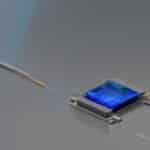Table of Contents
Semiconductors are substances with specific electrical properties that make them essential components in computers and electronic devices. These materials possess a unique capability to conduct electricity under certain conditions while acting as insulators under others, playing a pivotal role in controlling electrical current. Positioned between conductors and insulators in terms of conductivity, semiconductors are utilized to create a wide range of components, including diodes, integrated circuits, and transistors.
The conductance of a semiconductor can vary based on external factors such as current, voltage, or light. This versatility allows semiconductors to perform various functions in electronic systems, making them an integral part of modern technology.
Impurities, known as dopants, are added to semiconductors to determine their specific properties. By introducing these impurities, scientists and engineers can precisely control the behavior and conductivity of the material.
A diode, an essential semiconductor device, allows the flow of current in only one direction. Integrated circuits, also known as microchips, heavily rely on semiconductors to enable the miniaturization of complex electronic systems. Transistors, another vital semiconductor component, function as amplifiers and switches that control the flow of electrical signals within circuits.
Thanks to their unique electrical properties and conductance characteristics, semiconductors find extensive application in various industries. From consumer electronics like smartphones and laptops to embedded systems like home appliances and healthcare devices, semiconductors are crucial for control, interaction, and information processing. Some semiconductors are known for their high thermal conductivity, making them ideal for cooling applications. Additionally, semiconductors play a vital role in lighting technology, such as LED displays, and the production of solar cells for energy conversion.
The semiconductor industry, driven by the demand for microchips and constant innovation, experiences cyclical trends. The development and production of semiconductors involve a complex fabrication process, often outsourced to specialized manufacturers. Investors keen on capitalizing on this dynamic industry can monitor performance through relevant benchmarks, exchange-traded funds (ETFs), and indices.
How Semiconductors Work
Atoms are composed of a nucleus containing protons and neutrons, surrounded by a cloud of electrons. These electrons are arranged in layers called shells, with the outermost shell known as the valence shell. The behavior of electrons in the valence shell is crucial in determining the electrical properties of a material.
Conductors, such as metals, have only one electron in their valence shell. This allows them to easily share electrons and conduct electricity. In contrast, semiconductors typically have four electrons in their valence shell, which gives them unique electrical characteristics.
When atoms with the same valence come together, they can form covalent bonds by sharing pairs of electrons. This bonding leads to the formation of crystal structures, which are highly organized arrangements of atoms. Many semiconductors, including the widely used silicon, are made from crystal structures.
These crystal structures serve as the foundation for creating semiconductor devices like microchips. By strategically manipulating the behavior of electrons within the crystal structure, semiconductors can control the flow of electrical current and perform complex functions.
Here’s an image representing a crystal lattice structure of silicon:
The Covalent Bonding Model
“The unique properties of semiconductors arise from the covalent bonding between atoms and the resulting crystal lattice structure.” – Dr. Emily Chen, Materials Scientist
Understanding the intricacies of covalent bonds and crystal structures is essential for comprehending how semiconductors function. By manipulating the number and arrangement of electrons in the valence shell, engineers and scientists can tailor the electrical properties of semiconductors to suit specific applications.
N-type and P-type Semiconductors
In the world of semiconductor technology, there are two key types of semiconductors: N-type and P-type. These semiconductors play a crucial role in the functioning of various electronic devices.
An N-type semiconductor conducts current through the movement of negatively charged electrons. Similar to a conductor, electrons flow freely within the N-type semiconductor, enabling the transmission of electrical signals.
On the other hand, a P-type semiconductor conducts current through electron deficiencies known as holes. These holes have a positive electric charge and allow for the movement of positive charge carriers within the semiconductor material.
To understand the behavior of N-type and P-type semiconductors, it is essential to explore the structure of elemental semiconductors. Elemental semiconductors include antimony, arsenic, boron, carbon, germanium, selenium, silicon, sulfur, and tellurium. Among these, silicon is the most commonly used elemental semiconductor due to its abundance and desirable properties.
| N-type semiconductor | P-type semiconductor |
|---|---|
| – Conducts current through electrons | – Conducts current through holes |
| – Has an excess of negatively charged electrons | – Has a deficiency of electrons (presence of holes) |
| – Typically doped with impurities such as phosphorus or arsenic | – Typically doped with impurities such as boron or gallium |
| – Negatively charged | – Positively charged |
In certain specialized devices, a compound semiconductor called gallium arsenide is used due to its unique properties. Gallium arsenide offers advantages such as high electron mobility, high breakdown voltage, and excellent frequency response. This makes it a preferred choice for applications like amplifying devices and high-frequency electronic components.
Understanding the characteristics and differences between N-type and P-type semiconductors is crucial in the design and fabrication of semiconductor devices, enabling engineers to create efficient electronic systems and circuits.

Semiconductor Applications
Semiconductors play a critical role in a wide range of industries, offering diverse applications across various sectors. Let’s explore some of the key areas where semiconductors are utilized:
Consumer Electronics
In the realm of consumer electronics, semiconductors are essential components in devices that have become an integral part of our daily lives. Smartphones, laptops, tablets, and gaming consoles all rely on semiconductors to power their functionalities and enable seamless user experiences.
Embedded Systems
Embedded systems, found in numerous applications like central heating systems, fitness trackers, and automotive control units, heavily rely on semiconductors. These compact systems seamlessly blend into various environments and rely on semiconductors for precise control and interaction.
Thermal Conductivity
Some semiconductors possess excellent thermal conductivity properties, making them ideal for applications that require efficient cooling. These semiconductors effectively dissipate heat, allowing for the smooth operation of electronic devices that generate significant amounts of heat.
Lighting and LED Displays
Semiconductors are at the forefront of lighting technology, powering energy-efficient LED displays and lighting solutions. LEDs, or Light Emitting Diodes, utilize semiconductors to convert electricity into light, enabling vibrant displays and reducing power consumption.
Solar Cells
Semiconductors, particularly silicon, are extensively used in solar panels for the conversion of sunlight into electricity. These semiconductors facilitate the photovoltaic effect, allowing solar cells to generate renewable energy efficiently.
“Semiconductors have revolutionized various industries with their wide-ranging applications, spanning from consumer electronics to renewable energy solutions.”
| Industry | Application |
|---|---|
| Consumer Electronics | Smartphones, laptops, gaming consoles |
| Embedded Systems | Central heating systems, fitness trackers |
| Thermal Conductivity | Cooling solutions |
| Lighting and LED Displays | LED screens, energy-efficient lighting |
| Solar Cells | Solar panels for renewable energy |
As semiconductors continue to advance, their applications will expand further, revolutionizing industries and driving technological innovation.
The Semiconductor Industry
The semiconductor industry is an integral part of the production of microchips, which are essential components in electronic devices. Microchips, made from semiconductor materials like silicon, contain circuits with numerous transistors. These microchips can be classified into logic chips, responsible for processing information, and memory chips, which store information.
The semiconductor industry operates on the principles of continually making chips smaller, faster, and cheaper. This drive for improvement is in line with Moore’s Law, which states that the number of transistors on a microchip doubles approximately every two years. To achieve this, semiconductor fabrication methods are employed, ensuring precise manufacturing of microchips with high levels of integration.
In the semiconductor industry, there are different types of chip makers. One such type is the fabless chip makers, which focus on the design and marketing of chips without engaging in their actual fabrication. These companies outsource manufacturing to specialized foundries, allowing them to focus on innovation and development. This arrangement promotes collaboration and enables the production of cutting-edge chips.
Investing in the semiconductor industry requires a thorough understanding of the cyclicality of the market. Demand for microchips can vary based on factors such as technological advancements, consumer preferences, and economic conditions. Monitoring industry performance through benchmarks, exchange-traded funds (ETFs), and indices can be helpful for investors seeking to capitalize on opportunities in the semiconductor market.
FAQ
What is a semiconductor?
A semiconductor is a substance with specific electrical properties that make it ideal for use in computers and electronic devices. It can conduct electricity under certain conditions but not others, making it a medium to control electrical current. It sits between conductors and insulators in terms of conductivity.
What components are made from semiconductors?
Semiconductors are used to create various components such as diodes, integrated circuits, and transistors.
What determines the properties of a semiconductor?
The specific properties of a semiconductor are determined by impurities, known as dopants, that are added to it.
How do semiconductors conduct current?
An N-type semiconductor conducts current through the movement of negatively charged electrons, similar to a conductor. On the other hand, a P-type semiconductor conducts current through electron deficiencies called holes, which have a positive electric charge.
What are some examples of elemental semiconductors?
Elemental semiconductors include antimony, arsenic, boron, carbon, germanium, selenium, silicon, sulfur, and tellurium. Silicon is the most commonly used elemental semiconductor.
What are the applications of semiconductors?
Semiconductors have numerous applications across various industries. They are used in consumer electronics such as mobile phones, laptops, and gaming consoles. They are also used in embedded systems, lighting and LED displays, and solar panels for energy conversion. Certain semiconductors with high thermal conductivity can be used for cooling purposes.
What is the semiconductor industry?
The semiconductor industry plays a vital role in the production of microchips, which are essential components in electronic devices. Microchips are made using semiconductor materials, such as silicon, and contain circuits with numerous transistors. The industry operates on the principles of smaller, faster, and cheaper products. It is highly cyclical, with demand fluctuating based on market conditions.
How can I invest in the semiconductor industry?
Investors can monitor the performance of the semiconductor industry using benchmarks, ETFs, and indices. Chip production often involves outsourcing manufacturing to foundries and specialized designers. It is important to consider the cyclicality and market conditions when investing in the semiconductor industry.











